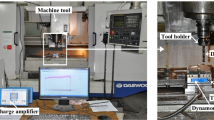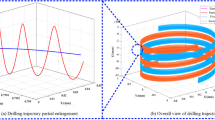Abstract
In this paper, the variation characteristic of the drilling force, and the influences of cutting speed, feed rate, and workpiece thickness on the drilling force, were evaluated when drilling a silicon carbide particle reinforced aluminum matrix (SiCp/Al) composite thin-walled workpiece with a high volume fraction. Under the condition that the workpiece thickness was less than the drill tip height, three characteristic stages of drilling force variation were proposed. The results indicate that there is a significant difference between the variations in the drilling force when drilling a thin-walled workpiece compared to thick-walled workpiece. When the chisel edge drills out the lower surface of the workpiece, there is an abrupt decrease in the thrust forces of the thin-walled and thick-walled workpieces. In addition, there is an abrupt decrease in the torque of the thick-walled workpiece, whereas that of the thin-walled workpiece increases. According to the thickness of the thin-walled workpiece, the instant of the abrupt decrease in the thrust force may lead or lag behind the theoretical instant at which the chisel edge reaches the lower surface of the workpiece without deformation. When drilling a thin-walled hole, the cutting speed has a slight influence on the thrust force, and there is a slight increase in the torque in accordance with an increase in the cutting speed. The thrust force and torque increase in accordance with an increase in the feed rate. When drilling a thin-walled workpiece with a thickness of 1 mm, the critical thickness of workpiece cracking decreases in accordance with an increase in the cutting speed, and increases in accordance with an increase in the feed rate. When drilling a thin-walled workpiece with a thickness of 0.5 mm, the concave deformation of the workpiece and the critical thickness of the workpiece cracking increase in accordance with an increase in the feed rate. However, the increment in the critical thickness of the workpiece cracking is less than that in the concave deformation of the workpiece.



















Similar content being viewed by others
References
Xiang JF, Xie LJ, Gao FN et al (2018) Diamond tools wear in drilling of SiCp/Al matrix composites containing copper. Ceram Int 44(5):5341–5351
Huang S, Guo L, He H et al (2017) Study on characteristics of SiCp/Al composites during high-speed milling with different particle size of PCD tools. Int J Adv Manuf Technol 95(5–8):2269–2279
Tosun G, Muratoglu M (2004) The drilling of an Al/SiCp metal-matrix composites. Part I: microstructure. Compos Sci Technol 64(2):299–308
Altunpak Y, Ay M, Aslan S (2012) Drilling of a hybrid Al/SiC/Gr metal matrix composites. Int J Adv Manuf Technol 60(5):513–517
Huang ST, Guo L, He HH et al (2018) Experimental study on SiCp/Al composites with different volume fractions in high-speed milling with PCD tools. Int J Adv Manuf Technol 97:2731–2739
Ekici E, Motorcu AR, Uzun G (2017) An investigation of the effects of cutting parameters and graphite reinforcement on quality characteristics during the drilling of Al/10B 4 C composites. Measurement 95:395–404
Paulo Davim J, Monteiro Baptista A (2000) Relationship between cutting force and PCD cutting tool wear in machining silicon carbide reinforced aluminium. J Mater Process Technol 103(3):417–423
Wang X, Guo J, Lin Y et al (2016) Study the effect of SiC content on the wear behavior and mechanism of as-extruded SiCp/Al-Cu-Mg-Zn alloy under simulating drilling operation. Surf Interface Anal 48(8):853–860
Chen X, Xie L, Nan X et al (2016) Experimental study on small-hole drilling characteristics of SiCp/Al composites. Procedia CIRP 46:319–322
Rajmohan T, Palanikumar K (2013) Application of the central composite design in optimization of machining parameters in drilling hybrid metal matrix composites. Measurement 46(4):1470–1481
Zhou YX, Xia YM (2000) Experimental study of the rate-sensitivity of SiCp/Al composites and the establishment of a dynamic constitutive equation. Compos Sci Technol 60(3):403–410
Palanikumar K, Muniaraj A (2014) Experimental investigation and analysis of thrust force in drilling cast hybrid metal matrix (Al-15%SiC-4%graphite) composites. Measurement 53:240–250
Xiang JF, Pang SQ, Xie LJ et al (2018) Mechanism-based FE simulation of tool wear in diamond drilling of SiCp/Al composites. Materials. https://doi.org/10.3390/ma11020252
Kadivar MA, Akbari J, Yousefi R et al (2014) Investigating the effects of vibration method on ultrasonic-assisted drilling of Al/SiCp metal matrix composites. Robot Comput Integr Manuf 30(3):344–350
Somasundaram G, Rajendra BS, Palanikumar K (2011) Modeling and analysis of roundness error in friction drilling of aluminum silicon carbide metal matrix composite. J Compos Mater 46(2):169–181
Tosun G (2010) Statistical analysis of process parameters in drilling of AlSi/Cp metal matrix composite. Int J Adv Manuf Technol 55(5–8):477–485
Seo YW, Kim D, Ramulu M (2006) Electrical discharge machining of functionally graded 15%–35% (volume fraction) SiCp/Al composites. Mater Manuf Process 21(5):479–487
Thakre AA, Soni S (2016) Modeling of burr size in drilling of aluminum silicon carbide composites using response surface methodology. Eng Sci Technol Int J 19(3):1199–1205
Basavarajappa S, Chandramohan G, Prabu M et al (2007) Drilling of hybrid metal matrix composites—workpiece surface integrity. Int J Mach Tools Manuf 47(1):92–96
Han JJ, Hao XQ, Li L et al (2017) Milling of high volume fraction SiCp/Al composites using PCD tools with different structures of tool edges and grain sizes. Int J Adv Manuf Technol 92:1875–1882
Ding X, Liew WYH, Liu XD (2005) Evaluation of machining performance of MMC with PCBN and PCD tools. Wear 259(7–12):1225–1234
Kremer A, Devillez A, Dominiak S et al (2008) Machinability of Al/SiC particulate metal-matrix composites under dry conditions with CVD diamond-coated carbide tools. Mach Sci Technol 12(2):214–233
Narahari P, Pai BC, Pillai RM (1999) Some aspects of machining cast Al-SiCp composites with conventional high speed steel and tungsten carbide tools. J Mater Eng Perform 8:538–542
Zhou L, Huang S, Xu L et al (2013) Drilling characteristics of SiCp/Al composites with electroplated diamond drills. Int J Adv Manuf Technol 69(5–8):1165–1173
Acknowledgements
This work is supported by the National Natural Science Foundation of China (Grant No. 51775356), the Distinguished Professor Funding Project of Liaoning Province, and the Key Laboratory Basic Research Project of the Department of Education of Liaoning Province (Grant No. LZ2015063).
Author information
Authors and Affiliations
Corresponding author
Rights and permissions
About this article
Cite this article
Huang, ST., Li, C., Xu, LF. et al. Variation characteristic of drilling force and influence of cutting parameter of SiCp/Al composite thin-walled workpiece. Adv. Manuf. 7, 288–302 (2019). https://doi.org/10.1007/s40436-019-00264-3
Received:
Revised:
Accepted:
Published:
Issue Date:
DOI: https://doi.org/10.1007/s40436-019-00264-3




